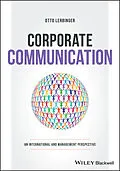Provides an international and management perspective on the field of corporate communication
Corporate communication plays an important role in higher-level management to help build and preserve a company's reputation. This intangible yet valuable asset determines the net worth of a company and affects the success of its operations. Corporate Communication: An International and Management Perspective introduces readers to the broad environment of the modern extended organization and provides an understanding of the globalization process. It describes how economic, political, and cultural features of a country affect company decisions and communication and discusses various communication disciplines and practices that are employed in programs and campaigns. This book addresses the key management issues of sustainability and technology and innovation. It also emphasizes the importance of why corporate communication must be seen as a management function and not restricted to a communication process.
Presented in five parts, Corporate Communication offers comprehensive chapters covering: The Domain of Corporate Communication; Strategic Application of Communication Practices; International Perspective; Key Management Issues of Sustainability and Technology; and Corporate Communication Contribution to Management. The foundation of Corporate Communication is public relations but also included is the entire range of communication practices and the contribution to management decision making.
* Conceptualizes corporate communication as a strategic management function which helps management recognize, adjust to, and construct policy related to global issues
* Emphasizes the critical role that corporate communication plays in making corporate decisions and behaviors more socially responsible and sustainable
* Demonstrates how corporate communication draws on public affairs, marketing and social media in its strategic planning
* Emphasizes the critical importance of relationships to corporations and their effect on reputation
* Provides numerous examples of cases of global problems and how corporations have responded to them
Corporate Communication is intended for upper-level undergraduate and graduate students in schools of communication and schools of business and management who want to extend their competence to the global arena and to combine the various communication practices to design strategic programs and campaigns. Course titles include corporate communication, international public relations, corporate public affairs, global marketing communication, global corporate communication, and social media.
Autorentext
OTTO LERBINGER, PHD, Economics Department, Massachusetts Institute of Technology, is Professor Emeritus of Public Relations at Boston University, specializing in corporate public affairs, crisis management, and international public relations. He has taught courses in Economic Behavior, Organizational Structure and Behavior, and Communication Theory. He also served as chairman of what is now the Department of Mass Communication, Advertising, and Public Relation, was Director of Research at the New York public relations firm of Ruder & Finn, and served as a consultant for several public relations firms. He has given lectures and seminars in Australia, Bahrain, Chile, China and Hong Kong, Colombia, England, and New Zealand.
Inhalt
Preface xiii
Acknowledgements xv
Author Biography xvii
Overview of the Book's Five Parts xix
Part I The Extended Enterprise 1
1 Introduction: The Domain of Corporate Communication 5
1.1 Stakeholder Management 6
1.2 Twin Goals of Corporate Communication 7
1.2.1 Strengthening Relationships with Stakeholders 7
1.2.2 Maintaining Corporate Reputation 9
1.3 Conclusions 11
Discussion Questions 12
2 Stakeholder Relations: Investors and Employees 15
2.1 Investor Relations 15
2.1.1 SEC's Full and Timely Disclosure Rules 16
2.1.2 Feedback and Power 16
2.1.3 Investor Relations Activities 17
2.2 Employee Relations 18
2.2.1 Maslow's Hierarchy of Needs 18
2.2.2 Employee Communications 19
2.2.3 Recruitment and Training of Workers 20
2.2.4 Helping Workers Adjust to Foreign Employers 22
2.2.5 Labor Unions and Collective Bargaining 22
2.2.6 Standardization vs. Customization of Employee Relations 24
2.3 Conclusions 24
Discussion Questions 25
3 Stakeholder Relations: The Community and Consumers 28
3.1 Community Relations 28
3.1.1 Programs and Activities 29
3.1.2 Importance in Oil and Mining Industries 30
3.1.3 Developing a Community Relations Program 31
3.2 Consumer Relationship Management (CRM) 31
3.2.1 Moving from a Transaction to a Relationship 32
3.2.2 Social Contract and Consumer Rights 33
3.2.3 Power Relationship 34
3.2.4 Social Responsibility to Consumers and Society 34
3.2.5 Emerging Concept of Social CRM 36
3.2.6 Privacy 37
3.3 Conclusions 38
Discussion Questions 38
Case 1 General Electric Profile of a Multi-National Corporation 40
Case 2 Wells Fargo Misapplies CRM 44
Part II Strategic Application of Communication Practices 51
4 Public Relations: Influencing Public Opinion 55
4.1 Historical Connection Between Public Relations and Public Opinion 56
4.1.1 The Public Relations Audit 56
4.1.2 Use of Surveys in Public Relations 57
4.1.3 Current Difficulties with Surveys 58
4.1.4 The Edelman Trust Barometer 59
4.1.5 CNBC/Burson-Marsteller Corporate Perception Indicator 59
4.1.6 Pew Research and Just Capital 60
4.2 Gaining Influence Through Publicity 60
4.2.1 Applying Perception Management: Putting a Spin on a Story 61
4.2.2 The Challenge Faced by Publicity: Limited Human Channel Capacity 62
4.2.3 Proactive Media Relations Strategy 62
4.2.4 Bernays A Prominent Publicist 62
4.2.5 Harold Burson Thoughts About Public Opinion 63
4.2.6 Proactive Media Relations 63
4.3 International Application of Persuasion 64
4.3.1 Public Diplomacy Campaigns 65
4.3.2 Business Support 65
4.3.3 Social Media Support 66
4.4 International Differences and Constraints in Media Relations 66
4.4.1 Use of Guanxi and Press Clubs 67
4.4.2 Unprofessional Practices 67
4.4.3 Constraints on Press Freedom 68
4.4.4 Singapore's Authoritarianism 69
4.4.5 Insult Laws 69
4.4.6 Concentrated Media Ownership 69
4.5 Conclusions 70
Discussion Questions 70
4.A Foreign Media Relations Guide 71
5 Public Affairs: Exercising Power in the Socio-Political Environment 76
5.1 Central Role of Government Relations 77
5.1.1 Government Relations in China 77
5.1.2 Cases of Intervention by Governments 77
5.2 Government Litigation 81
5.3 The Term Corporate Diplomacy Grows 82
5.4 Tools of Public Affairs 83
5.4.1 Negotiations 83
5.4.2 Lobbying 84
5.5 Conclusions 86
Di...
